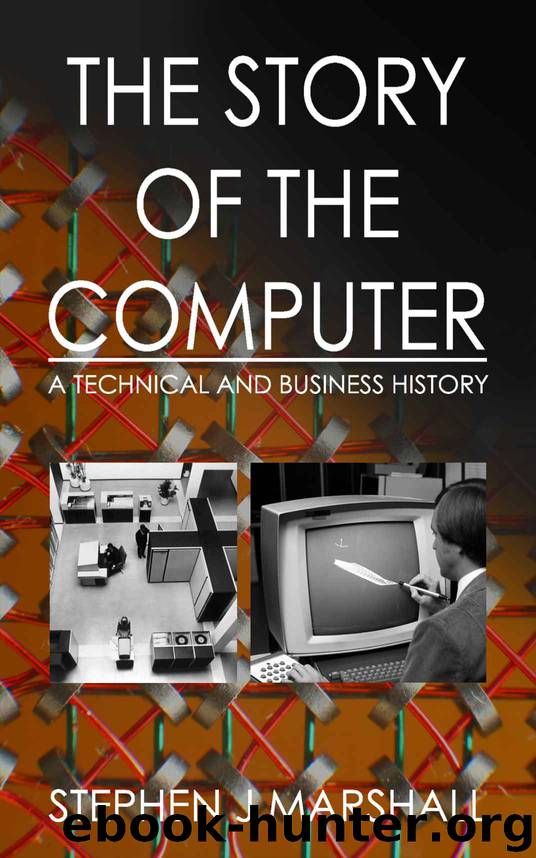The Story of the Computer by Marshall Stephen

Author:Marshall, Stephen
Language: eng
Format: epub
Publisher: Unknown
Published: 2015-03-10T16:00:00+00:00
The UNIVAC Solid-State
Despite IBM’s achievements in transistor technology and the huge financial investment made by the company in solid-state devices, the first computer manufacturer to enter the market with a solid-state general-purpose computer was IBM’s closest rival, Sperry Rand. The computer had its origins in a prototype machine built by Sperry Rand’s Philadelphia division for the US Air Force Cambridge Research Center (AFCRC).
Development of the Cambridge Air Force Computer, as it was known, began in 1952 and was completed by 1956. With a biquinary-coded decimal architecture, 10 decimal digit word length and magnetic drum memory, it bore a striking similarity to the IBM 650 Magnetic Drum Data Processing Machine. However, solid-state logic circuitry and a higher capacity 4,000 word drum gave the Sperry Rand machine a considerable advantage over the 3 year old IBM model, making a commercial version the obvious next step for Sperry Rand.
The production prototype was completed in December 1957 and was known as the Universal Card Tabulator or UCT. It featured a larger, faster drum of 5,000 words capacity, which further improved the specification over the IBM model. The drum rotated at the impressively high speed of 17,667 rpm and featured a helium filled drum casing to eliminate air friction. As the prototype had been developed prior to the introduction of reliable transistors, the arithmetic unit contained only 700 transistors, with the bulk of the circuitry constructed from 23,000 germanium diodes and 3,000 specially designed magnetic amplifiers known as Ferractors.
Contrary to the name that it would eventually be given, the Solid-State was not an entirely solid-state design. It also contained 20 valves and the choice of a magnetic drum rather than magnetic core storage for main memory, albeit an ultra high-speed one, further belied its pre-solid-state origins.
Unfortunately, the Solid-State was yet another victim of the internecine war that raged between the three computer divisions of Sperry Rand. The company had introduced its first medium-scale model, the St Paul division’s UNIVAC File-Computer, in early 1956 but sales of this quirky and expensive machine were sluggish. In order to give the File-Computer more time to establish itself in the lucrative US market, a decision was taken by Sperry Rand senior management not to introduce the faster, more reliable Solid-State model in the US but to restrict sales to the European market where it would retain the prototype’s UCT name. Costing around $450,000 for a typical system, the first production machine was delivered to the Dresdner Bank of Hamburg, West Germany, in October 1958.
Following pressure from potential customers, the UCT was eventually announced in the US as the UNIVAC Solid-State in December 1958, almost a year later than in Europe. Two versions were introduced, the Solid-State 80, with IBM-compatible 80 column punched cards, and the Solid-State 90 with UNIVAC-compatible 90 column cards. However, within less than a year IBM had introduced the IBM 1401, a transistorised replacement for the venerable IBM 650 which was considerably faster than the Solid-State due to its magnetic core main memory. Consequently, orders for the Solid-State soon began to dry up.
Download
This site does not store any files on its server. We only index and link to content provided by other sites. Please contact the content providers to delete copyright contents if any and email us, we'll remove relevant links or contents immediately.
Computer by Martin Campbell-Kelly; William Aspray; Nathan Ensmenger; Jeffrey R. Yost(606)
The Soul of a New Machine by Tracy Kidder(597)
Darwin Among the Machines by George B. Dyson(349)
Hackers heroes of the computer revolution by Steven Levy(343)
The Story of the Computer by Marshall Stephen(338)
Plain Text by Dennis Tenen(324)
Fire in the Valley by Paul Freiberger & Michael Swaine(318)
Reckoning with Matter: Calculating Machines, Innovation, and Thinking about Thinking from Pascal to Babbage by Jones Matthew L(316)
Great Moments in Computing by Mel Croucher & Robin Evans(316)
A Brief History of Computing by Gerard O'Regan(312)
The New Digital Age: Reshaping the Future of People, Nations and Business by Schmidt Eric & Cohen Jared(295)
Between Human and Machine: Feedback, Control, and Computing before Cybernetics (Johns Hopkins Studies in the History of Technology) by Mindell David A(283)
Colossus by Paul Gannon(274)
Computing: A Business History by Lars Nielsen(187)
Calculation and Computation in the Pre-electronic Era by Aristotle Tympas(169)
